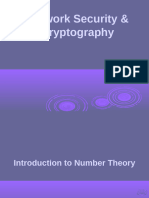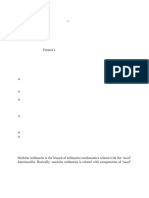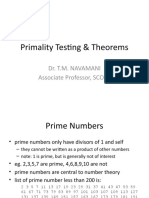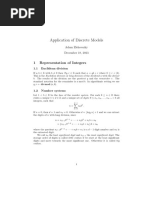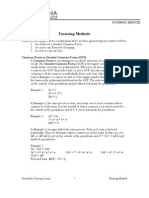0 ratings0% found this document useful (0 votes)
7 viewsModule 3-Number Theory
Uploaded by
rtrpavitrkocharCopyright
© © All Rights Reserved
Available Formats
Download as PPTX, PDF, TXT or read online on Scribd
0 ratings0% found this document useful (0 votes)
7 viewsModule 3-Number Theory
Uploaded by
rtrpavitrkocharCopyright
© © All Rights Reserved
Available Formats
Download as PPTX, PDF, TXT or read online on Scribd
You are on page 1/ 10
Module 3
Number Theory and Modular Arithmetic
Primality Testing
• Primality testing is the process of determining whether a given
number n is a prime number. A prime number is an integer greater
than 1 that has no positive divisors other than 1 and itself.
• Trial Division: The simplest method, checking divisibility by all
integers up to √n
• Based on Fermat's Little Theorem, it uses a random base a to check
whether an−1≡1mod n. If not, n is composite.
Fermat's Little Theorem
• Fermat's Little Theorem states that if p is a prime number and a is an
integer such that gcd(a,p)=1 then:
• ap−1≡ 1mod p
Implications:
• This theorem is useful in modular exponentiation and cryptography,
particularly in RSA encryption.
• It's also the basis for the Fermat primality test.
Euler's Theorem
• Euler's Theorem is a generalization of Fermat's Little Theorem. It states
that if n is a positive integer and a is an integer such that gcd(a,n)=1, then:
a^ϕ(n)≡1mod n
Where ϕ(n) is Euler's totient function, which counts the number of integers
less than n that are coprime to n.
• Applications:
• Euler’s theorem is fundamental in cryptography, especially in the RSA
algorithm.
• It helps in finding modular inverses and understanding the structure of
multiplicative groups modulo nnn.
Order of a Number
• The order of a number a modulo n is the smallest positive integer k
such that:
• a^k≡1mod n
Properties:
• The order of a divides ϕ(n).
• If a has order k modulo n, then a^j≡1mod n if and only if k divides j.
• Applications:
• Understanding the order of elements is essential in the study of cyclic
groups and cryptographic algorithms like Diffie-Hellman key exchange.
Primitive Roots
• A primitive root modulo n is an integer g such that the order of g modulo n is
ϕ(n). In other words, g generates all numbers coprime to n under
multiplication modulo n.
• Properties:
• Not every integer n has a primitive root. Primitive roots exist for n=2,4,p^k,
and 2p^k where p is an odd prime.
• If g is a primitive root modulo n, then every integer coprime to n is congruent
to some power of g.
• Applications:
• Primitive roots are crucial in number theory and are used in cryptographic
protocols such as the Diffie-Hellman key exchange.
Euclidean Algorithm
• The Euclidean algorithm is a method for finding the greatest common
divisor (GCD) of two integers a and b. It is based on the principle that
gcd(a,b)=gcd(b,amod b), and the algorithm repeatedly applies this
principle until b=0.
Steps:
• Start with two integers a and b.
• Replace a with b and b with a mod b.
• Repeat the process until b=0. The GCD is the last non-zero remainder.
Example on Euclidean Algorithm
Extended Euclidean Algorithm
• The Extended Euclidean Algorithm is an extension of the Euclidean
Algorithm that not only finds the GCD of two integers aaa and bbb, but
also expresses the GCD as a linear combination of aaa and bbb:
gcd(a,b)=ax+by
Steps:
• Perform the Euclidean algorithm to find the GCD.
• Work backwards to express the GCD as a linear combination of a and b.
Applications:
• Finding modular inverses in cryptography.
Examples
• Find the greatest common divisor (GCD) of a=252 and b=105 using
the Euclidean Algorithm.
• Steps:
• Initial Step:
• a=252, b=105
• Divide a by b and find the remainder: 252÷105=2 with a remainder of 42
• Replace a with b and b with the remainder: gcd(252,105)= gcd(105, 42)
• Gcd(105,42) = gcd (42,21)
• Gcd(42,21)=0
• Hence gcd(252,105) = 21 (last non zero remainder)
You might also like
- Visualizing and Representing Division and Writing Related Equation83% (6)Visualizing and Representing Division and Writing Related Equation25 pages
- lecture03 - Introduction to Number TheoryNo ratings yetlecture03 - Introduction to Number Theory64 pages
- Number Theory: Programming and Algorithms GroupNo ratings yetNumber Theory: Programming and Algorithms Group79 pages
- Cryptography and Network Security Chapter 2No ratings yetCryptography and Network Security Chapter 218 pages
- 3-Module - 1 Fundamentals of Number Theory-04-01-2024No ratings yet3-Module - 1 Fundamentals of Number Theory-04-01-202435 pages
- Cryptography and Network Security Self-Study: Submitted byNo ratings yetCryptography and Network Security Self-Study: Submitted by28 pages
- 02 Week2 Crypto Absics Extra Readings Number TheoryNo ratings yet02 Week2 Crypto Absics Extra Readings Number Theory28 pages
- Primality Testing & Theorems: Dr. T.M. Navamani Associate Professor, SCOPENo ratings yetPrimality Testing & Theorems: Dr. T.M. Navamani Associate Professor, SCOPE19 pages
- Anonymous - Elementary Number Theory and Primality TestsNo ratings yetAnonymous - Elementary Number Theory and Primality Tests117 pages
- Cryptography and Network Security: Seventh Edition by William StallingsNo ratings yetCryptography and Network Security: Seventh Edition by William Stallings34 pages
- Basics of Number Theory: Waleed Bin ShahidNo ratings yetBasics of Number Theory: Waleed Bin Shahid16 pages
- Basic Concepts in Number Theory and Finite Fields: Dr. T.M. Navamani Associate Professor, SCOPENo ratings yetBasic Concepts in Number Theory and Finite Fields: Dr. T.M. Navamani Associate Professor, SCOPE42 pages
- Number Theory and Public Key Cryptography: SyllabusNo ratings yetNumber Theory and Public Key Cryptography: Syllabus26 pages
- 10+2 Level Mathematics For All Exams GMAT, GRE, CAT, SAT, ACT, IIT JEE, WBJEE, ISI, CMI, RMO, INMO, KVPY Etc.From Everand10+2 Level Mathematics For All Exams GMAT, GRE, CAT, SAT, ACT, IIT JEE, WBJEE, ISI, CMI, RMO, INMO, KVPY Etc.No ratings yet
- Formula and Notes of Math Complex Number Doenload Maths Class 11 Chapter 5 Part 2No ratings yetFormula and Notes of Math Complex Number Doenload Maths Class 11 Chapter 5 Part 217 pages
- A Historia Da Humanidade, Do Seculo 4ac A 6ac.No ratings yetA Historia Da Humanidade, Do Seculo 4ac A 6ac.25 pages
- Interpreting Numerical Expressions Math Presentation in Light Blue Math Do - 20240121 - 223657 - 0000No ratings yetInterpreting Numerical Expressions Math Presentation in Light Blue Math Do - 20240121 - 223657 - 000017 pages
- SLC - Compulsory Math - Geometric Deduction0% (1)SLC - Compulsory Math - Geometric Deduction10 pages
- Fractions Lesson 4 Simplifying FractionsNo ratings yetFractions Lesson 4 Simplifying Fractions31 pages
- Mathematics in The Modern World: The Real Number SystemNo ratings yetMathematics in The Modern World: The Real Number System32 pages
- Visualizing and Representing Division and Writing Related EquationVisualizing and Representing Division and Writing Related Equation
- 3-Module - 1 Fundamentals of Number Theory-04-01-20243-Module - 1 Fundamentals of Number Theory-04-01-2024
- Cryptography and Network Security Self-Study: Submitted byCryptography and Network Security Self-Study: Submitted by
- 02 Week2 Crypto Absics Extra Readings Number Theory02 Week2 Crypto Absics Extra Readings Number Theory
- Primality Testing & Theorems: Dr. T.M. Navamani Associate Professor, SCOPEPrimality Testing & Theorems: Dr. T.M. Navamani Associate Professor, SCOPE
- Anonymous - Elementary Number Theory and Primality TestsAnonymous - Elementary Number Theory and Primality Tests
- Cryptography and Network Security: Seventh Edition by William StallingsCryptography and Network Security: Seventh Edition by William Stallings
- Basic Concepts in Number Theory and Finite Fields: Dr. T.M. Navamani Associate Professor, SCOPEBasic Concepts in Number Theory and Finite Fields: Dr. T.M. Navamani Associate Professor, SCOPE
- Number Theory and Public Key Cryptography: SyllabusNumber Theory and Public Key Cryptography: Syllabus
- 10+2 Level Mathematics For All Exams GMAT, GRE, CAT, SAT, ACT, IIT JEE, WBJEE, ISI, CMI, RMO, INMO, KVPY Etc.From Everand10+2 Level Mathematics For All Exams GMAT, GRE, CAT, SAT, ACT, IIT JEE, WBJEE, ISI, CMI, RMO, INMO, KVPY Etc.
- Formula and Notes of Math Complex Number Doenload Maths Class 11 Chapter 5 Part 2Formula and Notes of Math Complex Number Doenload Maths Class 11 Chapter 5 Part 2
- Interpreting Numerical Expressions Math Presentation in Light Blue Math Do - 20240121 - 223657 - 0000Interpreting Numerical Expressions Math Presentation in Light Blue Math Do - 20240121 - 223657 - 0000
- Mathematics in The Modern World: The Real Number SystemMathematics in The Modern World: The Real Number System





